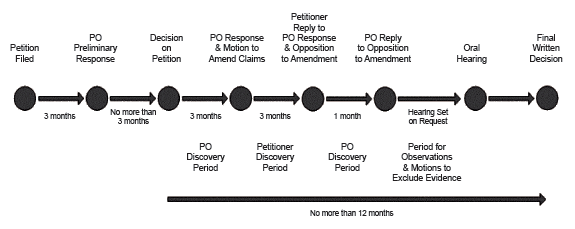On September 16, 2012, one year after the America Invents Act (AIA) was signed into law, the new Patent Trial and Appeal Board (PTAB) began accepting petitions for the new inter partes review (IPR) and covered business method review. No one could have predicted how quickly the PTAB would become one of the most favored jurisdictions for seeking invalidation of issued U.S. patents. In fact, the PTAB has more actions instituted on an annual basis than every judicial district with the exception of the Eastern District of Texas and the District of Delaware.
The process is quick and unforgiving, and it requires a statutorily mandated final written decision to be issued no more than 12 months from the date the petition to initiate a review is granted. The procedures permit the PTAB to review the patentability of one or more claims in an issued patent only on a ground that could be raised under §§ 102 or 103, and only on the basis of prior art consisting of patents or printed publications. In a petition for an inter partes review, the petitioner must by statute (i) identify all real parties in interest; (ii) identify all claims challenged and all grounds on which the challenge to each claim is based; and (iii) provide copies of evidence relied upon. The petition must be accompanied by a fee. In addition, the petitioner must by rule (i) identify the grounds for standing; (ii) provide a claim construction for each challenged claim; (iii) specifically explain the grounds for unpatentability; and (iv) specifically explain the relevance of evidence relied upon. Listed below is a basic timeline for the inter partes review proceedings:

With the speed and newness of these proceedings, the following are some points to keep in mind:
-
This is serious litigation. The PTAB has been granting close to 80 % of the petitions to institute an inter partes review. Moreover, the PTAB is ruling in favor of the petitioner at a rate of approximately 50 % of the time in its final decisions.
-
It is not uncommon for there to be parallel proceedings in district court. In these parallel proceedings the district courts are granting almost ¾ of the motions to stay the district court proceedings in favor of the inter partes review in front of the PTAB.
-
Although initially described as means to go after patent trolls, the patents being invalidated or cancelled are not limited to weak or poorly drafted patents, but include important electrical, computer and biotech patents owned by some of the largest corporations in the world.
-
PTAB uses the "broadest reasonable interpretation" of claims for patentability, whereas district courts use the "most reasonable claim interpretation," a narrower scope.
-
Expert testimony is generally crucial to a successful outcome. Although expert testimony is not permitted in the patent owner's preliminary response, it may be used in the form of a declaration (which has no page limitation) in support of the patent owners response (which is limited to 60 pages) to strengthen and provide additional support for the positions taken in the patent owner's response.
-
Always put considerable effort into the patent owner's preliminary response. This is your first opportunity to put your case forward to the Board, but more importantly, it may be used to persuade the Board to decline to review the patent.
Although a relatively new procedure, the inter partes review is fast becoming the forum for litigating issued patents. All companies, even small companies, with patents they consider important to their businesses, need to be prepared to successfully defend their patents in inter partes reviews at the PTAB.


 i
i


